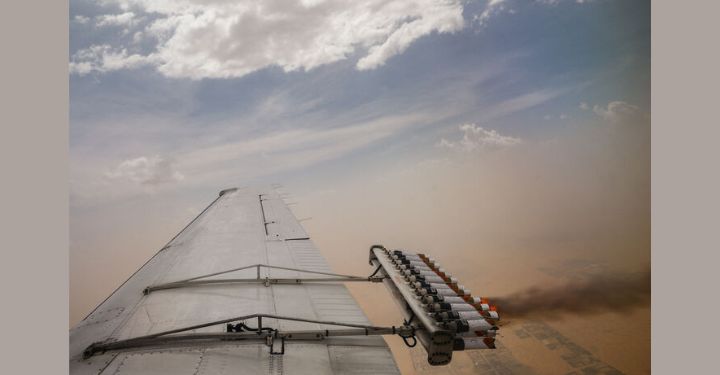Delhi’s ambitious attempt to manufacture rain through cloud-seeding has ended in disappointment, leaving both citizens and scientists under dry skies. The much-touted experiment, carried out jointly by the Delhi government and the Indian Institute of Technology Kanpur (IIT-Kanpur), aimed to provide temporary relief from the capital’s suffocating smog. But despite multiple flights, extensive planning, and several crores of taxpayer money, not a drop of meaningful rainfall fell over the city.
Officials had hoped that artificial showers would wash away pollutants and offer a brief respite to residents battling record-high pollution levels. Instead, the outcome has exposed the limits of weather modification — and raised tough questions about policy priorities, cost effectiveness, and scientific feasibility.
A Desperate Bid for Relief
Every winter, Delhi transforms into a gas chamber. Thick smog blankets the skyline, reducing visibility, choking lungs, and pushing the Air Quality Index (AQI) into the “severe” category. Hospitals see a surge in respiratory cases, schools are forced to close, and residents are advised to stay indoors.
In late October, as the AQI crossed 450 in several parts of the city, the government announced an emergency partnership with IIT-Kanpur to attempt artificial rainfall. The idea was simple but ambitious: if natural rain wasn’t coming, Delhi would make its own.
Cloud-seeding involves dispersing substances such as silver iodide, sodium chloride, or potassium chloride into existing clouds to encourage condensation and rainfall. The hope was that induced showers would settle particulate matter, reduce smog, and improve visibility for at least a few days.
The Operation
The Delhi government approved ₹3.2 crore for five cloud-seeding sorties, two of which were carried out in late October. Aircraft equipped with flare systems took off from Safdarjung and Hindon airports, targeting clouds over North, Central, and East Delhi, including areas such as Burari, Karol Bagh, and Mayur Vihar.
The flares were fired into clouds identified by radar as having potential for precipitation. Each flare released tiny particles that could act as nuclei for moisture to condense upon, forming raindrops. Ground-based monitoring stations were set up across nearly 300 square kilometers to record humidity, temperature, and pollution data before and after the experiment.
However, despite the technical precision, the operation produced little to no rain. A few light drizzles were recorded in pockets of Noida and Ghaziabad — 0.1 to 0.2 mm at most — but Delhi itself remained dry.
Why It Failed
According to Professor Manindra Agrawal, Director of IIT-Kanpur, the primary reason for failure was inadequate atmospheric moisture. “For successful cloud-seeding, clouds must have at least 50 to 60 percent relative humidity,” he explained. “During our trials, the moisture content was barely 15 percent.”
Without sufficient moisture, the released particles could not trigger condensation. The clouds simply did not have enough water vapor to form raindrops. Moreover, Delhi’s late-October atmosphere tends to be dry and stable, with limited vertical air movement — conditions that suppress natural rainfall and make artificial intervention difficult.
Meteorologists also noted that pollution itself may have played an ironic role in the failure. The high concentration of aerosols and fine particulate matter in Delhi’s air can disrupt the formation of large raindrops. Too many condensation nuclei lead to the creation of tiny droplets that remain suspended instead of falling as rain — a phenomenon known as the “aerosol suppression effect.”
Expert Opinions
Weather scientists say the results were predictable given the conditions. Dr. R.K. Jenamani, a senior meteorologist, commented, “Cloud-seeding can work only when the clouds are already rain-bearing. You cannot create rain from thin air. The timing of the experiment was not ideal.”
Environmentalists argue that the experiment reflects a growing reliance on quick technological fixes instead of long-term solutions. “Artificial rain may sound impressive, but it is only a cosmetic measure,” said Anumita Roychowdhury of the Centre for Science and Environment (CSE). “It can, at best, offer a few days of relief. The real battle lies in reducing emissions from vehicles, industries, and crop-burning.”
Still, IIT-Kanpur scientists defended the trial, calling it a “necessary step in experimentation.” While no significant rainfall occurred, valuable data was collected about Delhi’s cloud composition, wind patterns, and pollution levels — information that could help refine future weather-modification efforts.
Political Fallout
The outcome quickly became fodder for political controversy. The opposition Bharatiya Janata Party (BJP) accused the Delhi government of “playing politics with science” and wasting public money. “The project was rushed for publicity,” said BJP spokesperson Harish Khurana. “You cannot make rain by issuing press releases.”
The Aam Aadmi Party (AAP) government, however, defended its move. Environment Minister Gopal Rai stated that innovation involves risk and experimentation. “Science is about trial and error. Even if rain didn’t fall this time, we now have the data and experience to make better decisions in future.”
The minister also reminded critics that countries such as the United Arab Emirates and China routinely invest in cloud-seeding to augment rainfall and improve air quality, often with mixed but sometimes successful results.
The Cost of Chasing Clouds
Each seeding sortie cost around ₹60 lakh. Given Delhi’s vast size, experts estimate that a full-scale operation would require dozens of flights and continuous monitoring — potentially costing hundreds of crores. In comparison, the benefit, even if rain occurred, would likely last only two or three days before pollution levels rebounded.
Economists and environmental planners have thus questioned whether such expensive short-term interventions make sense. “It’s like spraying perfume in a smoky room,” said energy analyst Soumya Dutta. “You mask the problem for a while, but the smoke remains.”
Lessons and the Road Ahead
Despite its failure, the cloud-seeding trial has provided crucial insights. IIT-Kanpur scientists plan to analyze data from radar, humidity sensors, and particulate monitors to better understand Delhi’s microclimate. They have recommended conducting future trials during late November or early December, when western disturbances bring higher moisture levels to North India.
The Delhi government, meanwhile, has said that it will not abandon the idea entirely but will postpone further experiments until conditions are favorable. Officials emphasized that the broader anti-pollution strategy — including restrictions on vehicle emissions, construction dust control, and coordination with neighboring states — will continue.
Experts insist that the lesson is clear: while weather modification has potential, it cannot replace systemic reforms. Cleaner energy, sustainable transport, stricter enforcement, and regional cooperation are the only long-term solutions to Delhi’s chronic air crisis.
A Dry Ending and a Deeper Message
In the end, Delhi’s expensive foray into cloud-seeding has produced neither rain nor relief. But it has sparked an important debate about how far science can go in fixing human-made problems — and where political will must take over.
The sky over Delhi may have remained stubbornly dry, but the episode has at least shed light on something else: the need to stop looking upward for salvation, and start cleaning up on the ground.




